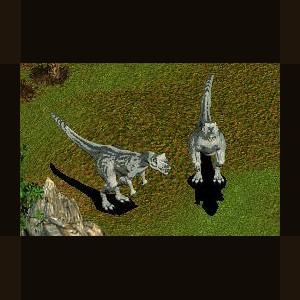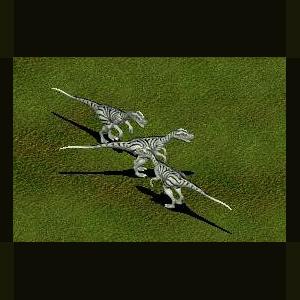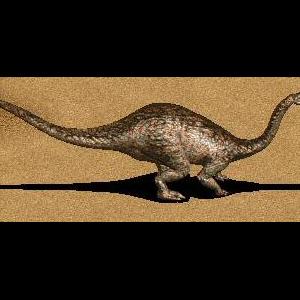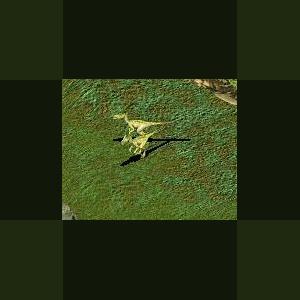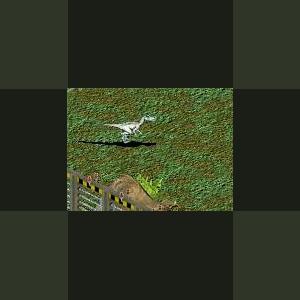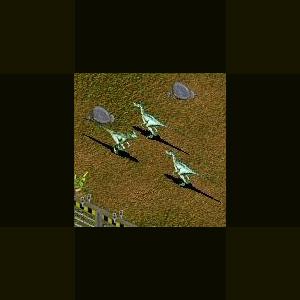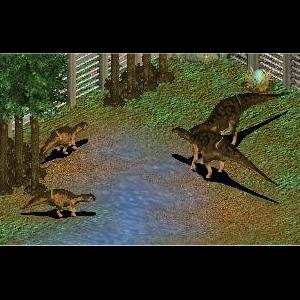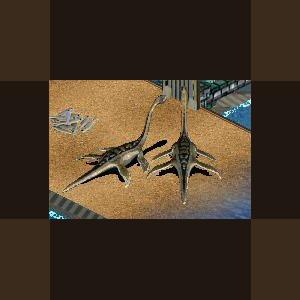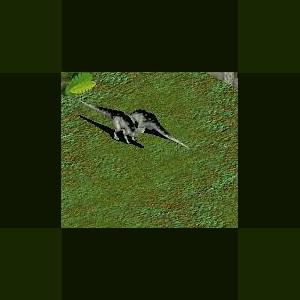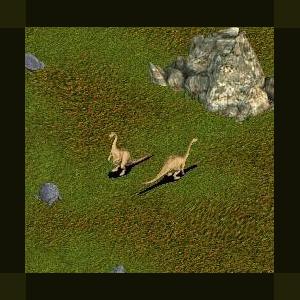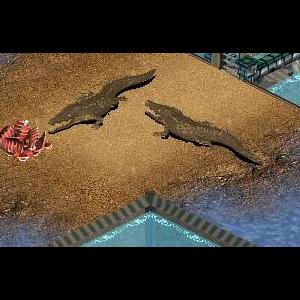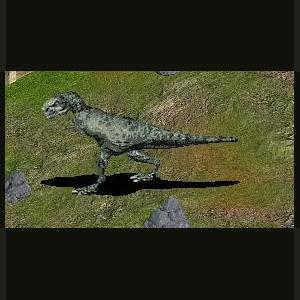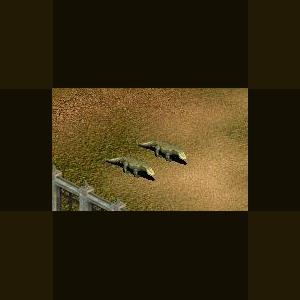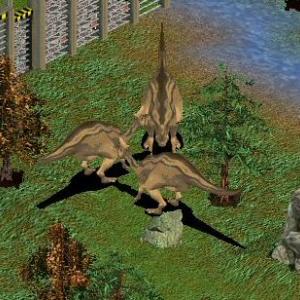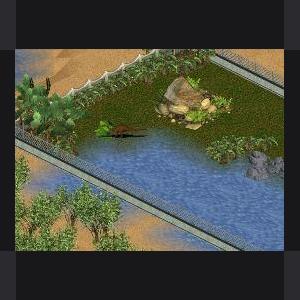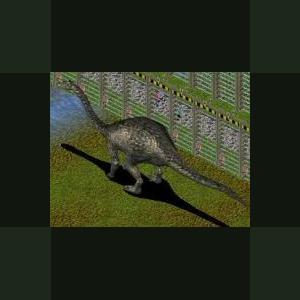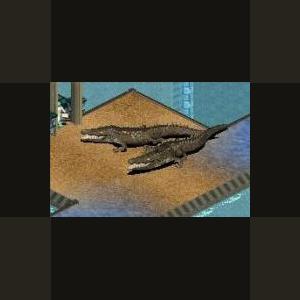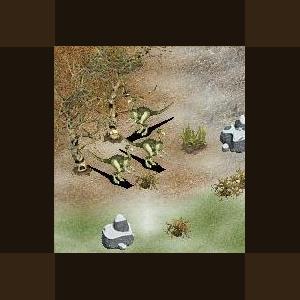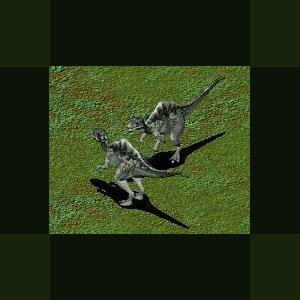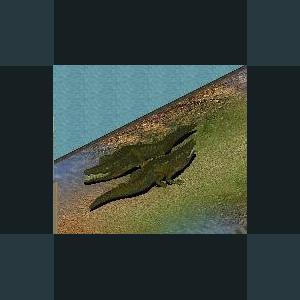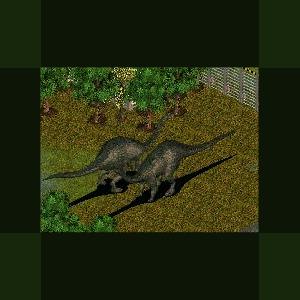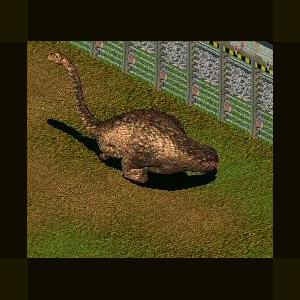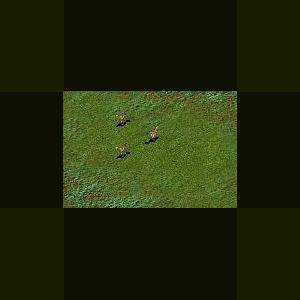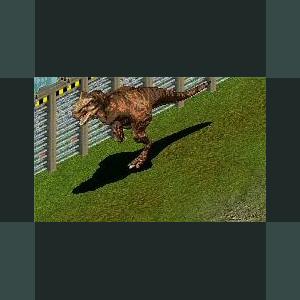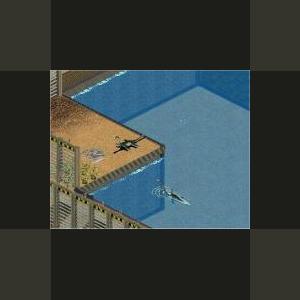Dinosaurs
Creatures from another age
241 files
-
Giganotosaurus by Moondawg
By Guest
Giganotosaurus (meaning 'giant southern lizard', derived from the Ancient Greek gigas meaning 'giant', notos meaning 'south wind' and saurus meaning 'lizard') was a genus of carcharodontosaurid dinosaur that lived 93 to 89
Giganotosaurus carolinii was named for Ruben Carolini, an amateur fossil hunter, who discovered the fossils in the deposits of the Rio Limay Formation of Patagonia, southern Argentina, in 1993. It was published by Rodolfo Coria and Leonardo Salgado in the journal Nature in 1995.
The holotype specimen's (MUCPv-Ch1) skeleton was about 70% complete and included the skull, pelvis, leg bones and most of the backbone. It is estimated around 12.2-12.5 m (40-41 ft) in length. A second specimen , 8% larger, has also been recovered. This largest Giganotosaurus specimen is estimated to represent an individual 13.2 m (43.3 ft) long, that weighed 6.2 tons. Giganotosaurus might have had the longest known skull for a theropod dinosaur, with the holotype's skull estimated at 1.80 m (6 ft) and the second specimen's estimated at 1.95 m (6.3 ft).[6] Giganotosaurus surpasses Tyrannosaurus rex in length by almost a meter (the upper length estimate for T. rex is 13 m).
Giganotosaurus, along with relatives like Tyrannotitan, Mapusaurus and Carcharodontosaurus, are members of the carnosaur family Carcharodontosauridae. Both Giganotosaurus and Mapusaurus have been placed in their own subfamily Giganotosaurinae by Coria and Currie in 2006 as more carcharodontosaurid dinosaurs are found and described, allowing interrelationships to be calculated
G. carolinii was slightly larger than T. rex but had a much smaller brain that was the size and shape of a banana. Its teeth were built more for cutting and slicing rather than crushing bones. A well-developed olfactory region means that it probably had a good sense of smell. Its skull, although large, had a slender build.
355 downloads
Updated
-
Ceratosaurus by Moondawg
By Guest
This therapod had a pair of bony ridges above its eyes and a horn on its snout. These were probably used by males when fighting for a mate.
Ceratosaurus (cera-TO-saur-US ) meaning 'horned lizard', in reference to the horn on its nose (Greek keras/keratos meaning 'horn' and sauros meaning 'lizard'), was a large predatory dinosaur from the Late Jurassic Period, found in the Morrison Formation of North America, in Tanzania and Portugal. It was characterized by large jaws with blade-like teeth, a large, blade-like horn on the snout and a pair hornlets over the eyes. The forelimbs were powerfully built but very short. The bones of the sacrum were fused (synsacrum) and the pelvic bones were fused together and to this structure (Sereno 1997) (i.e. similar to modern birds). A row of small osteoderms was present down the middle of the back.
351 downloads
Updated
-
Aegyptosaurus by Moondawg
By Guest
Aegyptosaurus meaning 'Egypt’s lizard', where it was discovered is a genus of dinosaur believed to have lived in what is now Africa, around 95 million years ago, during the mid- and late-Cretaceous Period.
351 downloads
0 comments
Updated
-
Achillobator by Moondawg
By Guest
Achillobator (meaning "Achilles' warrior/hero") is a genus of dromaeosaurid theropod dinosaur from the late Cretaceous Period of what is now Mongolia.
Fossil bones of Achillobator were found mostly disarticulated, but associated, including a fragment of the upper jaw with teeth, as well as vertebrae from all sections of the spinal column, ribs, and bones from the shoulder, pelvis, forelimbs and hindlimbs. These remains were found in the Bayan Shireh Formation of Dornogovi Province, Mongolia, which dates to the Late Cretaceous epoch. The exact age is uncertain, with two competing hypotheses; based on comparisons with other formations, the Bayan Shireh fauna seems to correspond best with the Turonian through early Campanian stages of the Late Cretaceous, about 93 to 80 million years ago. However, examination of the magnetostratigraphy of the formation seems to confirm that the entire Bayan Shireh lies within the Cretaceous Long Normal, which lasted only until the end of the Santonian stage, giving a possible Cenomanian through Santonian age, or between 98 and 83 million years ago. Other dinosaurs found in the Bayan Shireh include Alectrosaurus, Segnosaurus, Talarurus, and Bactrosaurus
349 downloads
Updated
-
Utahraptor by Moondawg
By Guest
Utahraptor (meaning "Utah's predator") is the largest known member of the theropod dinosaur family
Dromaeosauridae, and dates from the upper Barremian stage of the Early Cretaceous period (132-119 million years ago).
Like other dromaeosaurids, Utahraptor had a huge curved claw on the second toe that could grow to 23 centimetres (9.1 in) long. The animal may have grasped its prey with its forelimbs while kicking with its hindlimbs. Recent tests on reconstructions of the smaller Velociraptor suggest that claws of this type were used for stabbing or suffocating its prey, not slashing into their hide.Up to 6.5 m (21 ft) long, 2 m (6.6 ft) tall, and 700 kg (1,500 lb) in weight, Utahraptor would have been a formidable predator.
Updated by Cricket on April 5, 2012:
Removed space from name
Removed extra verbiage
348 downloads
Updated
-
Deinonychus by Moondawg
By Guest
This 3.4 metre (11 ft) long dinosaur lived during the early Cretaceous Period (Aptian - Albian stages, 121 to 98.9 million years ago). Fossils of the only named species (D. antirrhopus) have been recovered from the U.S. states of Montana, Wyoming and Oklahoma, though teeth that may belong to Deinonychus have been found much farther east in Maryland.
(Terrible claw) refers to the unusually large, sickle-shaped talon on the second toe of each hind foot, which was probably held up off the ground while the dinosaur walked on the third and fourth toes. It was commonly thought that Deinonychus would kick with the sickle claw to slash at its prey but recent tests on reconstructions of similar Velociraptor talons suggest that the claw was used to stab, not slash. The species name antirrhopus means (counter balance), which refers to John Ostrom's idea about the function of the tail. As in other dromaeosaurids, the tail vertebrae have a series of ossified tendons and super - elongated bone processes. These features seemed to make the tail into a stiff counterbalance, but a fossil of the very closely related Velociraptor mongoliensis has an articulated tail skeleton that is curved laterally in a long S – shape. This suggests that, in life, the tail could swish to the sides with a high degree of flexibility In both the Cloverly and Antlers Formation, Deinonychus remains have been found closely associated with those of the ornithopod Tenontosaurus. Teeth discovered associated with Tenontosaurus specimens imply it was hunted or at least scavenged upon by Deinonychus.
Paleontologist John Ostrom's study of Deinonychus in the late 1960s revolutionized the way scientists thought about dinosaurs, igniting the debate on whether or not dinosaurs were warm-blooded. Before this, the popular conception of dinosaurs had been one of plodding, reptilian giants. Ostrom noted lightweight bones and raptorial claws on the feet, which revealed an active, agile predator.
343 downloads
0 comments
Updated
-
Maiasaura by Ghirin
By Guest
Maiasaura
Author: Ghirin
http://www.zoo-tek.com/forums/index.php?download=782
Maiasaura ("Good Mother Lizard") formed large nesting colonies of up to 10,000 animals. Young Maiasaurs were cared for in the nest by adults until they were strong enough to follow the herd.
*Inspired by the Zoo Tycoon Brains Trust at the Zoo Tek Evolved Forums.*
342 downloads
0 comments
Updated
-
Futabasaurus Suzukii by Moondawg
By Guest
Futabasaurus Suzukii is the name of a plesiosaur that was described in 2006 by Sato, Hasegawa, and Manabe.
Futabasaurus comes from the Late Cretaceous of Fukushima, Japan, and was assigned to the family Elasmosauridae.
The name Futabasaurus also appears in connection with a theropod dinosaur, also from the Late Cretaceous of Japan. However, this dinosaur was not officially named, so the name Futabasaurus is a nomen nudum when applied to this theropod. It is not the same as the plesiosaur named Futabasaurus.
342 downloads
0 comments
Updated
-
Aralosaurus by Moondawg
By Guest
Aralosaurus (ar-ahl-o-SORE-us) meaning "Aral Sea lizard", because it was found in the Aral Sea when it began to shrink noticeably.Aralosaurus was a genus of hadrosaurid dinosaur which lived during the Late Cretaceous of what is now Kazakhstan.
Aralosaurus was characterized by a small, bony peak on its nose, much like its relatives Maiasaura and Gryposaurus. Some paleontologists have posited that Aralosaurus was actually a lambeosaurine.
Aralosaurus was a herbivore that lived in the late Cretaceous period, around 95 to 80 million years ago, and was capable of both bipedal and quadrupedal movement. Egg clusters show that Aralosaurus lived in herds and had locations for laying eggs where they would be safe.Several relatives, such as Jaxartosaurus have also been found in the surrounding area where Aralosaurus was found.
Aralosaurus was about the size of an elephant, being up to 9 m long, but was over 5,000 kilograms in weight. Although very little is known about Aralosaurus (only one near complete skull has been found); it was identified by a beak with nearly 1,000 small teeth in 30 rows. These teeth were used for breaking up plant matter by chewing, a feature common in herbivorous dinosaurs, but unusual for reptiles.The back of an Aralosaurus skull was wide, a feature suggestive of large jaw muscles used to power its chewing apparatus
334 downloads
0 comments
Updated
-
Anchisaurus by Moondawg
By Guest
Anchisaurus (from Greek anchi-; "near, close" + Greek sauros; "lizard", probably referring to Marsh's interpretation of it as intermediate between more primitive dinosaurs [at the time Palaeosaurus was an example of what was thought to be a primitive dinosaur] and more derived dinosaurs) is a genus of prosauropod dinosaur. The name Anchisaurus was coined as a replacement name for Amphisaurus, which was a replacement name for Hitchcock's Megadactylus, both of which had already been used for other animals.
The first discovery of Anchisaurus remains was made before anything was known about dinosaurs and it was probably the first dinosaur discovery in North America. When, in 1818, some large bones were discovered in Connecticut, USA, it was assumed that they were of human origin.Gradually, as a result of further finds in Massachusetts, the number of these bones began to accumulate and, by 1855, they were at least recognized as reptilian.
Hitchcock collected these bones under the name Megadactylus in 1865. Unfortunately, the name was in use, and the famous paleontologist Othniel Charles Marsh renamed it Anchisaurus in 1885. Remains thought to belong to this genus were found in South Africa and China, adding to the theory that these land masses were at the time joined in one super-continent, Pangaea, but these assignments have been contentious (Gyposaurus). A recovery from Nova Scotia may also be an Anchisaurus but this is unconfirmed.
Today, parts of Anchisaurus' skeleton are still missing. Reconstructions usually assume that the tail and neck were prosauropod-like. Recent analyses, however, put Anchisaurus firmly at the base of the Sauropoda, making it the most basal known sauropod.
Anchisaurus was a rather small dinosaur, with a length of just over 2 metres (6.6 ft), which helps explain why it was once mistaken for human bones. It probably weighed around 27 kilograms (60 lb). However, Marsh's species A. major (also known as Ammosaurus) was larger, from 2.5 to 4 metres (8 ft 2 in to 13 ft 1 in) and some estimates give it a weight of up to 70 pounds (32 kg). All species of Anchisaurus lived during the Early Jurassic Period; more specifically, the Pliensbachian to Toarcian ages, 200 to 188 million years ago.
Digesting plant matter is a much more intensive biochemical process than digesting meat. This herbivore swallowed gastroliths (gizzard stones) to help break down the food in its stomach. Herbivorous dinosaurs needed a huge gut. Since this had to be positioned in front of the pelvis, balancing on two legs became increasingly difficult, as dinosaurs became larger and they gradually evolved into the quadrupedal position that characterizes the later sauropods such as Diplodocus. Prosauropods represented a middle phase between the earliest bipedal herbivores and the later giant sauropods. Although it was not itself a prosauropod, Anchisaurus was mostly typical of this group, which flourished briefly during the late Triassic and early Jurassic. Anchisaurus teeth, used to rip food, were shaped like spoons. It had fewer and more widely spaced teeth than true prosauropods, and as Peter Galton and Michael Cluver observed, narrower feet. Anchisaurus would have spent most of its time on four legs but could have reared up on its hind legs to reach higher plants.
On the other hand, some paleontologists believe Anchisaurus may also have eaten meat, as it was in the transition between these two ultimately distinct groups. The teeth were blunt but with file-like edges, suggesting mostly plant matter was eaten and the jaw hinge was arranged in a way not entirely suited for tearing meat. Nevertheless, there is still some debate. The thumb had a large claw and the large eyes were not entirely on the side (as would be expected in an animal of a natural prey species).
As a quadrupedal/bipedal crossover, Anchisaurus had to have multi-purpose front legs. As 'hands', they could be turned inwards and be used for grasping. It had a simple reversible first 'finger', similar to a 'thumb'. As feet, the five toes could be placed flat against the floor and were strong at the ankle. This unspecialized design is typical of the early dinosaurs.
Due to its primitive appearance, Anchisaurus was previously classified as a prosauropod, a member of a group of animals related to or ancestral to the sauropods. Recent investigations show that Prosauropoda forms a monophyletic sister-group to Sauropoda and that Anchisaurus is instead a very basal sauropod.
Marsh was originally happy with Hitchcock's name Megadactylus but this name was already taken. Therefore, he renamed it Amphisaurus in 1882. However, this name was also already in use and therefore, it became Anchisaurus in 1885.
The type species is Hitchcock's A. polyzelus. Marsh's A. major ("greater near lizard") is still often considered a valid species (as Ammosaurus) but his A. colurus (1891), once known as Yaleosaurus (von Huene, 1932), is now generally accepted as a female A. polyzelus, and his A. solus of 1892 is now reclassified as Ammosaurus major. However, Ammosaurus major itself may well be a synonym of A. polyzelus.
Broom named Gyposaurus capensis in 1911, from the bones discovered in South Africa but Peter Galton officially renamed it A. capensis in 1976. This species has since been reclassified again and is probably a juvenile of Massospondylus carinatus. G. sinensis was also referred here, but appears to be a distinct animal. Other specimens are still awaiting reclassification. This confusion is typical of the first dinosaurs to be discovered, when classification was not considered as important and precise a process as today.
333 downloads
Updated
-
Sarcosuchus Imperator by Moondawg
By Guest
Sarcosuchus meaning 'flesh crocodile' and commonly called "SuperCroc", is an extinct genus of crocodile.
It dates from the early Cretaceous Period of what is now Africa and is one of the largest giant crocodile-like reptiles that ever lived. It was almost twice as long as the largest modern crocodile and weighed up to 10 times as much.
Until recently, all that was known of the genus was a few fossilised teeth and armour scutes, which were discovered in the Sahara Desert by the French paleontologist Albert-Félix de Lapparent, in the 1940s or 1950s. However, in 1997 and 2000, Paul Sereno discovered half a dozen new specimens, including one with about half the skeleton intact and most of the spine. All of the other giant crocodiles are known only from a few partial skulls, so which is actually the biggest is an open question.
When fully mature, Sarcosuchus is believed to have been as long as a city bus (11.2–12.2 meters or 37–40 ft) and weighed up to 8 tonnes (8.75 tons). The largest living crocodilian, the saltwater crocodile, is less than two-thirds of that length (6.3 meters or 20.6 ft is the longest confirmed individual) and a small fraction of the weight (1,200 kg, or 1.3 tons).
The very largest Sarcosuchus is believed to have been the oldest. Osteoderm growth rings taken from an 80% grown individual (based on comparison to largest individual found) suggest that Sarcosuchus kept growing throughout its entire 50–60 year average life span (Sereno et al., 2001). Modern crocodiles grow at a rapid rate, reaching their adult size in about a decade, then growing more slowly afterwards.
Its skull alone was as big as a human adult (1.78 m, or 5 ft 10 inches). The upper jaw overlapped the lower jaw, creating an overbite. The jaws were relatively narrow (especially in juveniles). The snout comprises about 75% of the skull's length (Sereno et al., 2001).
The huge jaw contained 132 thick teeth (Larsson said they were like "railroad spikes. The teeth were conical, adapted for grabbing and holding; instead of narrow, adapted for slashing (like the teeth of some land-dwelling carnivores), and more like that of true crocodilians. Sarcosuchus could probably exert a force of 80 kN (18,000 lbf) with its jaw, making it very unlikely that prey could escape.
It had a row of bony plates or osteoderms, running down its back, the largest of which were 1 m (3 ft) long. The scutes served as armour and may have helped support its great mass, but also restricted its flexibility.
Sarcosuchus also had a strange depression at the end of its snout. Called a bulla, it has been compared to the ghara seen in gharials. Unlike the ghara, though, the bulla is present in all Sarcosuchus skulls that have been found so far. This suggests it was not a sexually selected character (only the male gharial has a ghara). The purpose of this structure remains enigmatic. Sereno and others asked various reptile researchers what their thoughts on this bulla were. Opinions ranged from it being an olfactory enhancer to being connected to a vocalization device.
333 downloads
0 comments
Updated
-
Appalachiosaurus by Moondawg
By Guest
Appalachiosaurus
Appalachiosaurus (pronounced ap-a-LAYCH-ee-oh-SAWR-us; "Appalachian lizard") is a genus of tyrannosauroid theropod dinosaur from the Late Cretaceous Period of eastern North America. Like almost all theropods, it was a bipedal predator. Only a juvenile skeleton has been found, representing an animal over 7 meters (23 ft) long and weighing over 600 kilograms (1300 lb), which indicates an adult would have been even larger. This species is notable as the most completely known theropod from the eastern part of North America.
This dinosaur was named after the region of the central United States known as Appalachia, which also gave its name to the ancient island continent on which Appalachiosaurus lived. Both are named after the Appalachian Mountains. The generic name also includes the Greek word sauros ("lizard"), the most common suffix used in dinosaur names. There is one known species, A. montgomeriensis, which is named after Montgomery County in the U.S. state of Alabama. Both genus and species were named in 2005 by paleontologists Thomas Carr, Thomas Williamson, and David Schwimmer (who is not to be confused with the actor of the same name).
Fossils of Appalachiosaurus were found in central Alabama, from the Demopolis Chalk Formation. This formation dates to the middle of the Campanian stage of the Late Cretaceous, or around 77 million years ago (Carr et al., 2005).
Appalachiosaurus is so far known from only partial remains, including parts of the skull and mandible (lower jaw), as well as several vertebrae, parts of the pelvis, and most of both hindlimbs. These remains are housed at the McWane Science Center in Birmingham, Alabama. There are several open sutures between bones of the skull, indicating that the animal was not an adult. Several elements are crushed, but the specimen is still informative and shows many unique characteristics, or apomorphies. Several of these apomorphies have been identified in the skull, and the claws of the feet show an unusual protrusion on the end closest to the body. A row of six low crests lines the top of the snout, similar to the Asian Alioramus, although most tyrannosaur species exhibit ornamentation to varying degrees on top of the snout. Appalachiosaurus is significantly different and more derived than another early tyrannosaur from eastern North America, Dryptosaurus.
Appalachiosaurus is complete enough to be included in phylogenetic analyses using cladistics. The first was performed before the animal had had even been named, and found Appalachiosaurus to be a member of the albertosaurine subfamily of Tyrannosauridae, which also includes Albertosaurus and Gorgosaurus (Holtz, 2004). The original description also included a cladistic analysis, finding A. montgomeriensis to be a basal tyrannosauroid outside of Tyrannosauridae (Carr et al., 2005). However, Asian tyrannosaurs like Alioramus, and Alectrosaurus were excluded, as was Eotyrannus from England. Earlier tyrannosaurs such as Dilong and Guanlong had not been described at the time this analysis was performed. These exclusions may have a significant effect on the phylogeny. To date, no analysis has been published which includes all known tyrannosauroid taxa.
329 downloads
0 comments
Updated
-
Baurusuchus by Moondawg
By Guest
Baurusuchus is an extinct genus of baurusuchid mesoeucrocodylian from the Late Cretaceous of South America.
325 downloads
Updated
-
Corythosaurus by Moondawg
By Guest
Corythosaurus
Corythosaurus meaning 'helmet lizard' because of the shape of its crest (Greek korythos meaning 'helmet' and sauros meaning 'lizard') was a genus of duck-billed dinosaur from the Upper Cretaceous Period, about 80 million years ago. It lived in what is now North America.
The first specimen was discovered in 1912 by Barnum Brown in Red Deer River, Alberta, Canada. As well as an almost complete skeleton, the find was remarkable because much of the creature's fossilized skin had also survived. In 1916, the Canadian (Canadian Pacific Lines) ship Mount Temple was carrying two specimens and other fossils from today's Dinosaur Provincial Park, Alberta, Canada to Britain. It was sunk by the German surface raider SMS Moewe, sending its 75 million year old cargo to the bottom of the North Atlantic, where it rests to this day.
There were originally up to seven species described including C. casaurius, C. bicristatus, C. brevicristatus, C. excavatus, C. frontalis, and C. intermedius. In 1975 Peter Dodson studied the differences between the skulls and crests of different species of lambeosaurine dinosaurs. He found that the differences in size and shape may have actually been related to the gender and age of the animal. Now only one species is recognized, C. casuarius.
Corythosaurus is classified as a hadrosaurid, in the subfamily Lambeosaurinae. It is related to other hadrosaurs such as Hypacrosaurus, Lambeosaurus and Olorotitan, with the exception of Olorotitan they all share similar looking skulls and crests. However, recent research has suggested that Olorotitan is Corythosaurus closest known relative even though it doesn't share as many skull characteristics as other lambeosaurs.
Corythosaurus weighed in at 4 tonnes and measured roughly 10 metres (35 ft) from nose to tail. Like other hadrosaurs it had a toothless beak, the back of the jaws contained a dental battery composed of hundreds of small, interlocking teeth. These were used to crush and grind plant matter and were continually replaced as they wore away.
Over 20 skulls have been found from this dinosaur. As with other lambeosaurs, the animal bore a tall, elaborate bony crest atop its skull, which contained the elongate nasal passages. The nasal passages extended into the crest, first into separate pockets in the sides, then into a single central chamber and onward into the respiratory system.
Any vocalization would travel through these elaborate chambers, and probably get amplified. Scientists speculate that Corythosaurus could make loud, low pitched cries "Like a wind or brass instrument." The sounds could serve to alert other Corythosaurus to the presence of food or a potential threat from a predator.
It was once thought that this dinosaur lived mostly in the water, due to the appearance of webbed hands and feet. However, it was later discovered that the so-called "webs" were in fact deflated padding, much like that found on many modern mammals.
319 downloads
0 comments
Updated
-
Mokele Mbembe by Ghirin
By Guest
Mokele-mbembe, a name that means "One who stops the flow of rivers", is a legendary animal from the Likouala swamp region of the Central African Republic. It is usually described as having a small head on a long neck, a long, tail, rounded feet with three claws on each foot, and to be intermediate in size between an elephant and a hippopatamus The skin is hairless and reddish brown in color.
Mokele-mbembe is said to live in the pools and wetlands near rivers. It is herbivorous, prefering the malambo plant (Landolphia sp.). The animal is reported to spend most of its time in the water, only coming onto dry land to feed.
Some cryptozoologists believe that Mokele-mbembe is a surviving population of sauropod dinosaurs from the Mesozoic era. Many reports of the creature have come from the Congo region and several expeditions have been organized, but no actual specimenes, living or dead have been recovered for scientific study.
*Inspired by the Zoo Tycoon Brains Trust at the Zoo Tek Forums.
References:
http://www.mokelembembe.com/
http://www.geocities.com/Area51/Cavern/7270/mokele.html
http://www.angelfire.com/mi/dinosaurs/mokele.html
http://www.occultopedia.com/m/mokele_mbembe.htm
Created by Ghirin 2004
312 downloads
0 comments
Updated
-
Aragosaurus by Moondawg
By Guest
Aragosaurus (meaning "Aragon lizard") was a genus of sauropod dinosaur from the Early Cretaceous period of Galve, Teruel, in the province of Aragón, Spain.
Aragosaurus was a large, quadrupedal plant-eating (herbivorous) dinosaur, which lived about 130-120 million years ago, in the Hauterivian-Barremian. It was about 60 ft (18 m) in length and about 28000 kg in weight.
Like other sauropods, it had a long neck, a long powerful tail, a small head and a bulky body. It was broadly similar to Camarasaurus. It is represented by a partial fossil, which was found in Spain and was named by Sanz, Buscalioni, Casanovi and Santafe in 1987. The type species is A. ischiaticus. Like Camarasaurus, Aragosaurus probably had a short, compact skull and a moderately long neck. The teeth were large and wide, and would have been useful for slicing through the leaves and branches of tall conifer trees. The forelimbs were only a little shorter than the hind limbs, and the tail was long and muscular.
309 downloads
0 comments
Updated
-
Purussaurus by Moondawg
By Guest
Purussaurus was a giant caiman living in South America, 20 million years ago (Miocene). It is only known from skull material found in Peruvian Amazonia.
The skull is about 1.5 meters (5 ft), and paleontologists estimate that the whole body would have measured around 15 meters (50 ft), which means that Purussaurus is one of the largest crocodilians known to have ever existed. Two other extinct crocodilians, Sarcosuchus and Deinosuchus, have similar proportions, but both are geologically much older, dating from the Early and Late Cretaceous, respectively. During the summer of 2005, a franco-peruvian expedition (the Fitzcarrald expedition) found new fossils of Purussaurus in Amazonia (600 km from Lima).
Purussaurus was a giant caiman living in South America during the Miocene epoch, 8 million years ago. It is known from skull material found in the Brazilian, Colombian and Peruvian Amazonia, besides in the north of Venezuela. The skull is about 1.5 meters (5 ft) long, and paleontologists estimate that the whole body would have measured around 12 meters, which means that Purussaurus is one of the largest crocodilians known to have ever existed. Two other extinct crocodilians, Sarcosuchus and Deinosuchus, have similar proportions, but both are geologically much older, dating from the Early and Late Cretaceous, respectively, and another from around the same era, the Rhamphosuchus, is also estimated to be of similar size. During the summer of 2005, a Franco-Peruvian expedition (the Fitzcarrald expedition) found new fossils of Purussaurus in Amazonia (600 km from Lima).
309 downloads
Updated
-
Leaellynasaura by Moondawg
By Guest
Leaellynasaura
Leaellynasaura was a small herbivorous ornithopod dinosaur of about 60-90 cm in length from the earliest Cretaceous, first discovered in Dinosaur Cove, Australia.
It was an Australian polar dinosaur. Strangely enough, at this period in time, Victoria would have been well within the Antarctic Circle, which is now very cold. This means that Leaellynasaura was living and apparently thriving much further south than any reptile could today. This is particularly relevant due to Cryolophosaurus being discovered in Antarctica, thus further suggesting the idea that dinosaurs could live under conditions which were once thought unsuitable for their kind. It is possible that the sun would not have risen for several weeks or months in the winter, depending on latitude, which means that Leaellynasaura would have had to live in the dark for perhaps months at a time. This is particularly relevant to the fact that Leaellynosaura had very big eyes and its brain had large optic lobes, as if it had evolved to be routinely active in the dark.Evidence found on the coast of western Victorian coastline suggests that polar dinosaurs, such as Leaellynasaura, may have dug burrows to nurture their young during the polar winter.
Regardless, the fact that it lived in extremely cold temperatures led many scientists to believe that Leaellynasaura was warm-blooded.
No complete skeletons have been found of Leaellynasaura. The species is known from many isolated limb bones, ribs, vertebrae, jaws, teeth and one partial skull.
The type species is Leaellynasaura amicagraphica. It was described in 1989. It was named after Leaellyn Rich, the daughter of the palaeontologist couple Tom Rich and Patricia Vickers-Rich who discovered it. Leaellynasaura was a hypsilophodont, a rather basal ornithopod. Like all ornithopods, it was a herbivore.
308 downloads
Updated
-
Irritator by Moondawg
By Guest
Irritator is a genus of spinosaurid dinosaur that lived in the early Cretaceous Period (Albian stage), around 110 million years ago.
Current estimations indicate a length of 8 meters (26 feet) and a height of 3 meters (9 feet). It was found in Brazil. Irritator was a theropod with an unusually shaped crest at the rear of its head, and probably ate fish.
So far the only fossil that has been found was an 80 centimeter long fossil skull in the Romualdo Member, a layer member of the Brazilian Santana formation. This skull strongly resembles the skulls of Suchomimus and Spinosaurus. The genus is often regarded today as identical (synonymous) with Angaturama, which lived in the same time and the same place as Irritator.
Irritator was first scientifically described in 1996 by paleontologists Martill, Cruikshank, Frey, Small and Clarke. Its only known fossil, an 80cm skull discovered in eastern Brazil, was badly obscured by plaster which was added by the commercial fossil-collecting amateurs who discovered it, and illegally sold it, since the trade of fossils is prohibited by law in Brazil, in hopes of making the fossil look more complete and valuable. It required a great deal of work to reconstruct the original features — hence the name.
It is probably synonymous with Angaturama limai, another spinosaurid from the same time and place, whose remains curiously seem to complete Irritator's skull, meaning that they could belong to the same specimen.
Material of I. challengeri, not counting that of A. limai, hails from the Romualdo Member of the Santana Formation in Brazil. The holotype is SMNS 58022, from the Stuttgart State Museum of the Natural Sciences, and it consists of an incomplete skull, lacking the anterior (front) portion.
The skull was recovered nearly complete and is considered the most complete head find of a Spinosaurid. It is characterized particularly by its unusual length and curved lip region, which is strongly compressed laterally. The overall length of the complete head is estimated at approximately 84 centimeters. It possesses a clear Sagittal crest; such a comb is found also with some other dinosaurs. The teeth exhibit a single embedding of the strongly extended and straight teeth with conical tooth crowns, which indicates a continual tooth change, as new teeth were pushed up between the old ones. The teeth exhibit lengths from 6 to approximately 40 millimeters.
In the year 2004 parts of a spinal column were discovered in the Santana Formation. These have been assigned, due to their structure, to the Spinosauridae. With very high probability these fossils belong to Irritator, since this is the so far the only so far well-known Spinosaurid of the formation.
Sorry I couldn't make the sail smaller so i left it as is :D
305 downloads
0 comments
Updated
-
DinoCroc by Moondawg
By Guest
DinoCroc
Dinocroc is a 2004 horror film about a prehistoric carnivore, Sarcosuchus imperator. It is resurrected in a genetics laboratory after being mixed with a modern day crocodile, resulting in a hybrid monstrosity that has a lot in common with the Spinosaurus. It escaped the lab in a run-of-the-mill American town, and begins devouring the residents.
305 downloads
Updated
-
Titanosaurus by Ghirin
By Guest
Titanosaurus (“Titanic Lizard”) was the first found of a distinct group of sauropods, the Titanosauria. This group of sauropods lasted from the late Jurassic to the late Cretaceous periods and seems to be indigenous to the southern hemisphere.
Titanosaurus looked similar to the Diplodocidae, having both a long neck and a whip-like tail. However, the skin on its back was studded with small bony plates called osteoderms.
References:
http://dinosauricon.com/genera/titanosaurus.html
Encyclopedia of Dinosaurs and Other Prehistoric Creatures. Malam and Parker, 2002
Dinosaurs. Parker, 2003
Created by Ghirin, 2004
299 downloads
0 comments
Updated
-
Barapasaurus by Moondawg
By Guest
Barapasaurus is curious because it is the earliest known sauropod, dating from the early Jurassic Period — more precisely the Toarcian age, about 189.6 to 176.5 million years ago. This is evident in the unspecialized nature of its form. Later sauropods like Brachiosaurus developed their own ecological niche and feeding strategies. However, Barapasaurus was something of an "all-purpose" dinosaur. For example, later sauropods developed hollow vertebrae, as a weight-saving measure. Barapasaurus vertebrae, on the other hand, were almost solid, with only the earliest hints of hollowing. (See also: Camarasaurus.)
Despite its early place in dinosaur history, Barapasaurus reached a length of about 18 metres (60 feet), and weighed about 48 tones (53 tons). Its height to the hip was approximately 5.5 metres (18 feet).
Like all sauropods, Barapasaurus was a herbivore. However, no skull has yet been recovered and so its exact diet has not been determined. A few lone teeth are known but not sufficient to make judgments on diet.
Barapasaurus is also important because, although its remains were found in India, it is very similar to other samples found in East Africa. From this we can conclude that during the early Jurassic period, these two land masses were still connected or at least only recently divorced.
Barapasaurus is included in Vulcanodontidae rather than Cetiosauridae, another family in Sauropoda. This classification is unconfirmed since insufficient work has been done on the skeletons. The description is justified by the narrow sacrum (a boxlike structure of the hip), which is a characteristic of vulcanodontids. However, the dorsal vertebrae display features shared with Cetiosauridae, such as a high neural arch above the vertebral foramen.
Currently the only known species is the original B. tagorsi.
The first bones of Barapasaurus were recovered in India in 1960. However, it was not until 1975 that this recovery was made the type specimen, and the official description published by Jain, Kutty, Roy-Chowdhury and Chatterjee of Calcutta.
Since then, five additional skeletons have been recovered from the Godavari Valley in southern India. However, none of these included the skull or feet. The remainder of the skeleton is known, so it is theoretically the best-known of the early Jurassic sauropods. Unfortunately, little work has yet been published regarding these discoveries.
296 downloads
0 comments
Updated
-
Microraptor by Moondawg
By Guest
Microraptor had two sets of wings, on both its fore- and hind legs. The long feathers on the legs of Microraptor were true flight feathers as seen in modern birds, with asymmetrical vanes on the arm, leg, and tail feathers. As in bird wings, Microraptor had both primary (anchored to the hand) and secondary (anchored to the arm) flight feathers. This standard wing pattern was mirrored on the hind legs, with flight feathers anchored to the upper foot bones as well as the upper and lower leg. It had been proposed by Chinese scientists that the animal glided, and probably lived in trees, pointing to the fact that wings anchored to the feet of Microraptor would have hindered their ability to run on the ground, and suggest that all primitive dromaeosaurids may have been arboreal.
Sankar Chatterjee determined in 2005 that, in order for the creature to glide or fly, the wings must have been split-level (like a biplane) and not overlayed (like a dragonfly), and that the latter posture would have been anatomically impossible. Using this biplane model, Chatterjee was able to calculate possible methods of gliding, and determined that Microraptor most likely employed a phugoid style of gliding--launching itself from a perch, the animal would have swooped downward in a deep 'U' shaped curve and then lifted again to land on another tree. The feathers not directly employed in the biplane wing structure, like those on the tibia and the tail, could have been used to control drag and alter the flight path, trajectory, etc. The orientation of the hind wings would also have helped the animal control its gliding flight. Chatterjee also used computer algorithms that test animal flight capacity to test whether or not Microraptor was capable of true, powered flight, in addition to passive gliding. The resulting data showed that Microraptor did have the requirements to sustain level powered flight, so it is theoretically possible that the animal flew on occasion in addition to gliding.
Some paleontologists have suggested that feathered dinosaurs used their wings to parachute from trees, possibly in order to attack or ambush prey on the ground, as a precursor to gliding or true flight. In their 2007 study, Chatterjee and Templin tested this hypothesis as well, and found that the combined wing surface of Microraptor was too narrow to successfully parachute to the ground without injury from any significant height. However, the authors did leave open the possibility that Microraptor could have parachuted short distances, as between closely spaced tree branches.
Chatterjee and Templin also ruled out the possibility of a ground-based takeoff. Microraptor lacked the necessary adaptations in its shoulder joint to lift its front wings high enough vertically to generate lift from the ground, and the authors argued that a ground-based takeoff would have damaged flight feathers on the feet. This leaves only the possibility of launching from an elevated perch, and the authors noted that even modern birds do not need to use excess power when launching from trees, but use the downward-swooping technique they found in Microraptor.
The unique wing arrangement found in Microraptor raised the question of its importance to the origin of flight in modern birds--did avian flight go through a four-winged stage, or were four-winged gliders like Microraptor an evolutionary side-branch that did not leave descendants? As early as 1915, some scientists had argued that the evolution of bird flight may have gone through a four-winged (or tetrapteryx) stage. Chatterjee and Templin did not take a strong stance on this possibility, noting that both a conventional interpretation and a tetrapteryx stage are equally possible. However, based on the presence of unusually long leg feathers in various feathered dinosaurs, Archaeopteryx, and some modern birds such as raptors, as well as the discovery of Pedopenna (another dinosaur with long primary feathers on its feet), the authors argued that the current body of evidence, both from morphology and phylogeny, suggests that bird flight did shift at some point from shared limb dominance to front-limb dominance, and that all modern birds may have evolved from four-winged ancestors, or at least ancestors with unusually long leg feathers relative to the modern configuration.
The naming of Microraptor is controversial, because of the unusual circumstances of its first description. The first specimen to be described was part of a chimeric specimen , a patchwork of unrelated feathered dinosaur species assembled from multiple specimens in China and smuggled to the USA for sale. After the forgery was revealed by Xu Xing of Beijing's Institute of Vertebrate Paleontology and Paleoanthropology, Storrs L. Olson, curator of birds in the National Museum of Natural History of the Smithsonian Institution, published a description of the tail in an obscure journal, giving it the name Archaeoraptor liaoningensis in an attempt to remove the name from the paleornithological record by assigning it to the part least likely to be a bird. However, Xu had discovered the remainder of the specimen from which the tail had been taken and published a description of it later that year, giving it the name Microraptor zhaoianus.
Since the two names designate the same individual as the type specimen, Microraptor zhaoianus is a junior objective synonym of Archaeoraptor liaoningensis and the latter, if valid, has priority. So, according to some interpretations of the International Code of Zoological Nomenclature, the valid name for this dinosaur probably is Archaeoraptor liaoningensis Olson 2000. However, there is some doubt whether Olson in fact succeeded in meeting all the formal requirements for establishing a new taxon. Most paleontologists are unwilling to use the name Archaeoraptor regardless of the precise legal status of the name. This is firstly because that name is strongly associated with the fraud and the National Geographic scandal and secondly because they view Olson's use of the name as attempted nomenclatural sabotage and do not want to support it. The name Microraptor zhaoianus Xu et al., 2000 has therefore almost attained universal currency.
293 downloads
0 comments
Updated
-
Gorgosaurus by Moondawg
By Guest
Like most known tyrannosaurids, Gorgosaurus was a multi-ton bipedal predator equipped with dozens of large, sharp teeth; it also bore tiny two-fingered forelimbs typical of its close relatives. Although relatively large for a theropod, Gorgosaurus was much smaller than its more famous relative Tyrannosaurus.
Gorgosaurus (pronounced GOR-go-SAWR-us; meaning "fierce lizard") is a genus of tyrannosaurid theropod dinosaur that lived in western North America during the Late Cretaceous Period, between about 77 and 74 million years ago. Fossil remains have been found in the Canadian province of Alberta and possibly the U.S. state of Montana. Paleontologists recognize only the type species, G. libratus, although other species have been erroneously referred to the genus.
Like most known tyrannosaurids, Gorgosaurus was a bipedal predator weighing more than a metric ton as an adult; dozens of large, sharp teeth lined its jaws, while its two-fingered forelimbs were comparatively small. Gorgosaurus was most closely related to Albertosaurus, and more distantly related to the larger Tyrannosaurus. Gorgosaurus and Albertosaurus are extremely similar, distinguished mainly by subtle differences in the teeth and skull bones. Some experts consider G. libratus to be a species of Albertosaurus; this would make Gorgosaurus a junior synonym of that genus.
Gorgosaurus lived in a lush floodplain environment along the edge of an inland sea. An apex predator, it was at the top of the food chain, preying upon abundant ceratopsids and hadrosaurs. In some areas, Gorgosaurus coexisted with another tyrannosaurid, Daspletosaurus. Though these animals were roughly the same size, there is some evidence of niche differentiation between the two. Gorgosaurus is the best-represented tyrannosaurid in the fossil record, known from dozens of specimens. These plentiful remains have allowed scientists to investigate its ontogeny, life history and other aspects of its biology.
291 downloads
0 comments
Updated
-
Cryptocleidus by Ghirin
By Guest
Cryptocleidus Author: Ghirin
Cryptocleidus ("Hidden Collar Bone") was a genus of plesiosaur from the late Jurassic period. Its fossils were found in Europe.
*Inspired by the Zoo Tycoon Brains Trust at the Zoo Tek Evolved Forums.
290 downloads
0 comments
Updated

